Stefan Ivić
Ergodic exploration of dynamic distribution
Mar 14, 2025Abstract:This research addresses the challenge of performing search missions in dynamic environments, particularly for drifting targets whose movement is dictated by a flow field. This is accomplished through a dynamical system that integrates two partial differential equations: one governing the dynamics and uncertainty of the probability distribution, and the other regulating the potential field for ergodic multi-agent search. The target probability field evolves in response to the target dynamics imposed by the environment and accomplished sensing efforts, while being explored by multiple robot agents guided by the potential field gradient. The proposed methodology was tested on two simulated search scenarios, one of which features a synthetically generated domain and showcases better performance when compared to the baseline method with static target probability over a range of agent to flow field velocity ratios. The second search scenario represents a realistic sea search and rescue mission where the search start is delayed, the search is performed in multiple robot flight missions, and the procedure for target drift uncertainty compensation is demonstrated. Furthermore, the proposed method provides an accurate survey completion metric, based on the known detection/sensing parameters, that correlates with the actual number of targets found independently.
Experimental validation of UAV search and detection system in real wilderness environment
Feb 24, 2025Abstract:Search and rescue (SAR) missions require reliable search methods to locate survivors, especially in challenging or inaccessible environments. This is why introducing unmanned aerial vehicles (UAVs) can be of great help to enhance the efficiency of SAR missions while simultaneously increasing the safety of everyone involved in the mission. Motivated by this, we design and experiment with autonomous UAV search for humans in a Mediterranean karst environment. The UAVs are directed using Heat equation-driven area coverage (HEDAC) ergodic control method according to known probability density and detection function. The implemented sensing framework consists of a probabilistic search model, motion control system, and computer vision object detection. It enables calculation of the probability of the target being detected in the SAR mission, and this paper focuses on experimental validation of proposed probabilistic framework and UAV control. The uniform probability density to ensure the even probability of finding the targets in the desired search area is achieved by assigning suitably thought-out tasks to 78 volunteers. The detection model is based on YOLO and trained with a previously collected ortho-photo image database. The experimental search is carefully planned and conducted, while as many parameters as possible are recorded. The thorough analysis consists of the motion control system, object detection, and the search validation. The assessment of the detection and search performance provides strong indication that the designed detection model in the UAV control algorithm is aligned with real-world results.
Model predictive altitude and velocity control in ergodic potential field directed multi-UAV search
Jan 05, 2024Abstract:This research addresses the challenge of executing multi-UAV survey missions over diverse terrains characterized by varying elevations. The approach integrates advanced two-dimensional ergodic search technique with model predictive control of UAV altitude and velocity. Optimization of altitude and velocity is performed along anticipated UAV ground routes, considering multiple objectives and constraints. This yields a flight regimen tailored to the terrain, as well as the motion and sensing characteristics of the UAVs. The proposed UAV motion control strategy is assessed through simulations of realistic search missions and actual terrain models. Results demonstrate the successful integration of model predictive altitude and velocity control with a two-dimensional potential field-guided ergodic search. Adjusting UAV altitudes to near-ideal levels facilitates the utilization of sensing ranges, thereby enhancing the effectiveness of the search. Furthermore, the control algorithm is capable of real-time computation, encouraging its practical application in real-world scenarios.
Fast algorithm for centralized multi-agent maze exploration
Oct 03, 2023Abstract:Recent advancements in robotics have paved the way for robots to replace humans in perilous situations, such as searching for victims in blazing buildings, earthquake-damaged structures, uncharted caves, traversing minefields, or patrolling crime-ridden streets. These challenges can be generalized as problems where agents need to explore unknown mazes. Although various algorithms for single-agent maze exploration exist, extending them to multi-agent systems poses complexities. We propose a solution: a cooperative multi-agent system of automated mobile agents for exploring unknown mazes and locating stationary targets. Our algorithm employs a potential field governing maze exploration, integrating cooperative agent behaviors like collision avoidance, coverage coordination, and path planning. This approach builds upon the Heat Equation Driven Area Coverage (HEDAC) method by Ivi\'c, Crnkovi\'c, and Mezi\'c. Unlike previous continuous domain applications, we adapt HEDAC for discrete domains, specifically mazes divided into nodes. Our algorithm is versatile, easily modified for anti-collision requirements, and adaptable to expanding mazes and numerical meshes over time. Comparative evaluations against alternative maze-solving methods illustrate our algorithm's superiority. The results highlight significant enhancements, showcasing its applicability across diverse mazes. Numerical simulations affirm its robustness, adaptability, scalability, and simplicity, enabling centralized parallel computation in autonomous systems of basic agents/robots.
Multi-UAV trajectory planning for 3D visual inspection of complex structures
Apr 21, 2022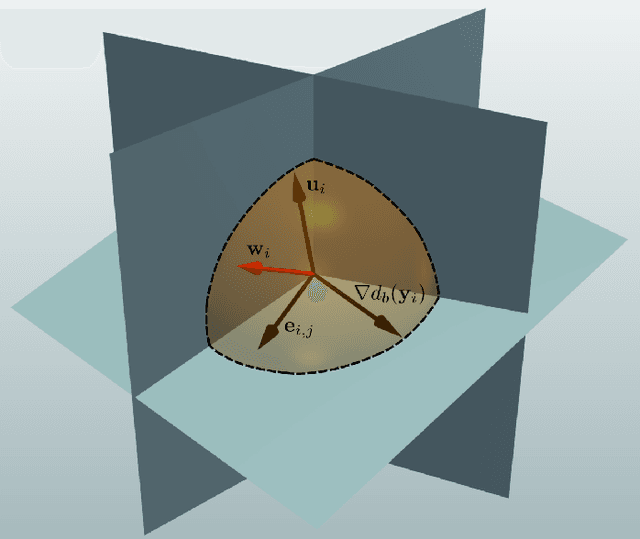
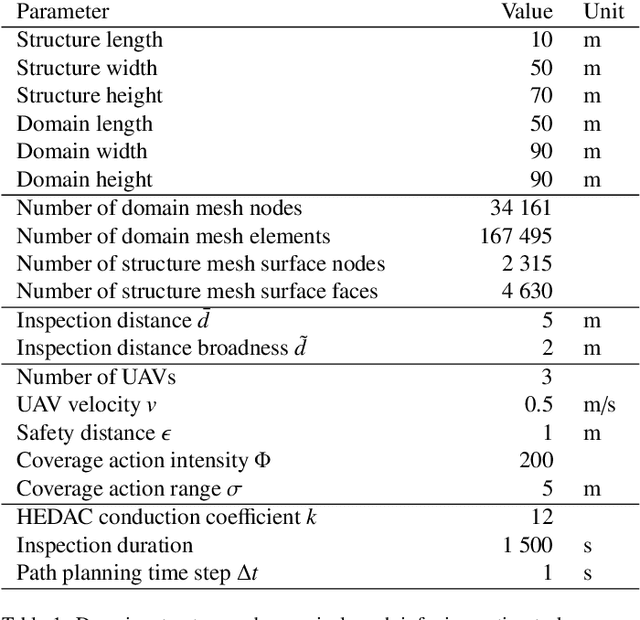
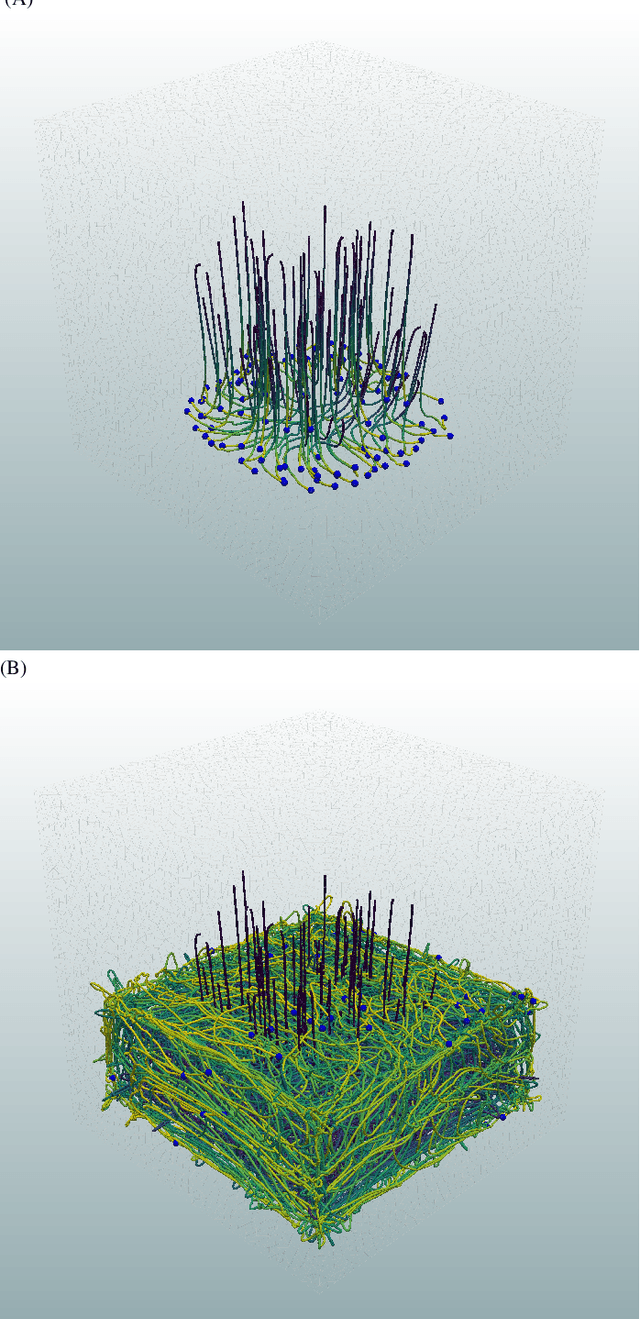
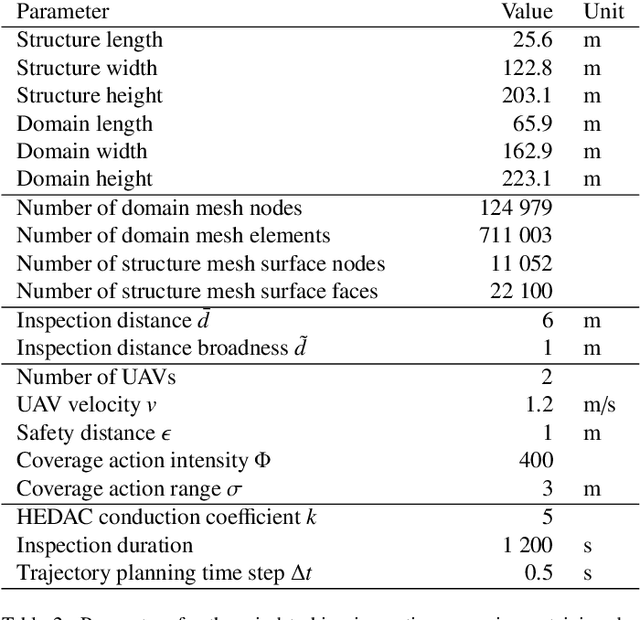
Abstract:This paper presents a new trajectory planning algorithm for 3D autonomous UAV volume coverage and visual inspection. The algorithm is an extension of a state-of-the-art Heat Equation Driven Area Coverage (HEDAC) multi-agent area coverage algorithm for 3D domains. With a given target exploration density field, the algorithm designs a potential field and directs UAVs to the regions of higher potential, i.e., higher values of remaining density. Collisions between the agents and agents with domain boundaries are prevented by implementing the distance field and correcting the agent's directional vector when the distance threshold is reached. A unit cube test case is considered to evaluate this trajectory planning strategy for volume coverage. For visual inspection applications, the algorithm is supplemented with camera direction control. A field containing the nearest distance from any point in the domain to the structure surface is designed. The gradient of this field is calculated to obtain the camera orientation throughout the trajectory. Three different test cases of varying complexities are considered to validate the proposed method for visual inspection. The simplest scenario is a synthetic portal-like structure inspected using three UAVs. The other two inspection scenarios are based on realistic structures where UAVs are commonly utilized: a wind turbine and a bridge. When deployed to a wind turbine inspection, two simulated UAVs traversing smooth spiral trajectories have successfully explored the entire turbine structure while cameras are directed to the curved surfaces of the turbine's blades. In the bridge test case an efficacious visual inspection of a complex structure is demonstrated by employing a single UAV and five UAVs. The proposed methodology is successful, flexible and applicable in real-world UAV inspection tasks.
Constrained multi-agent ergodic area surveying control based on finite element approximation of the potential field
Oct 12, 2021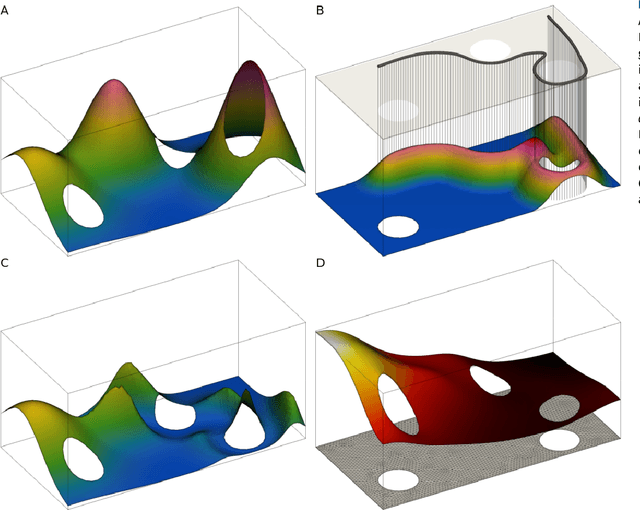
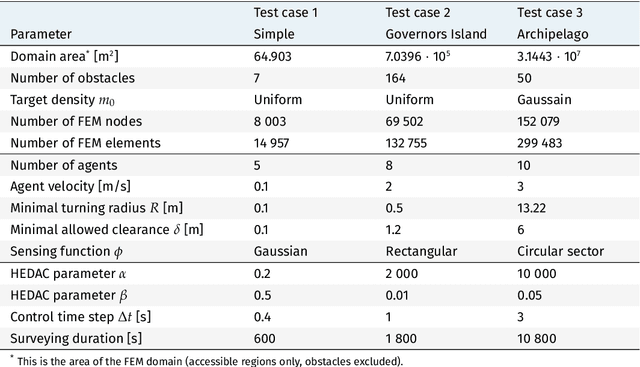

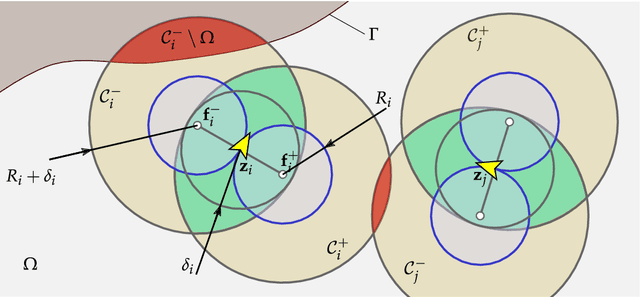
Abstract:Heat Equation Driven Area Coverage (HEDAC) is a state-of-the-art multi-agent ergodic motion control guided by a gradient of a potential field. A finite element method is hereby implemented to obtain a solution of Helmholtz partial differential equation, which models the potential field for surveying motion control. This allows us to survey arbitrarily shaped domains and to include obstacles in an elegant and robust manner intrinsic to HEDAC's fundamental idea. For a simple kinematic motion, the obstacles and boundary avoidance constraints are successfully handled by directing the agent motion with the gradient of the potential. However, including additional constraints, such as the minimal clearance dsitance from stationary and moving obstacles and the minimal path curvature radius, requires further alternations of the control algorithm. We introduce a relatively simple yet robust approach for handling these constraints by formulating a straightforward optimization problem based on collision-free escapes route maneuvers. This approach provides a guaranteed collision avoidance mechanism, while being computationally inexpensive as a result of the optimization problem partitioning. The proposed motion control is evaluated in three realistic surveying scenarios simulations, showing the effectiveness of the surveying and the robustness of the control algorithm. Furthermore, potential maneuvering difficulties due to improperly defined surveying scenarios are highlighted and we provide guidelines on how to overpass them. The results are promising and indiacate real-world applicability of proposed constrained multi-agent motion control for autonomous surveying and potentially other HEDAC utilizations.
Anakatabatic Inertia: Particle-wise Adaptive Inertia for PSO
Jul 31, 2020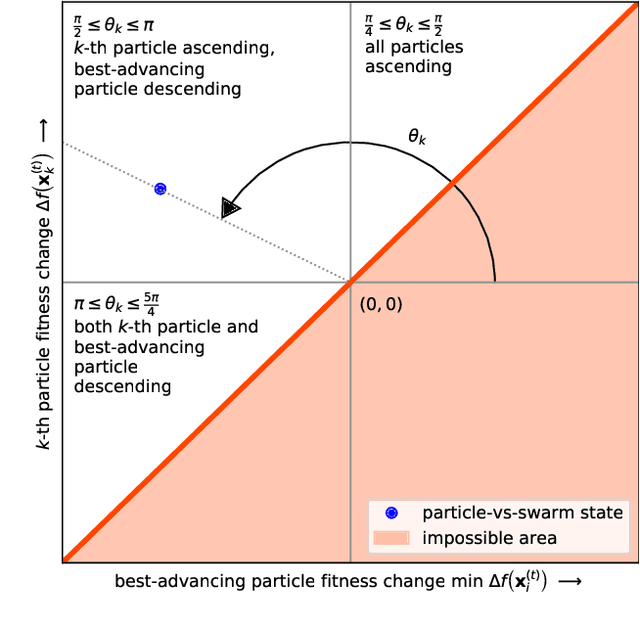

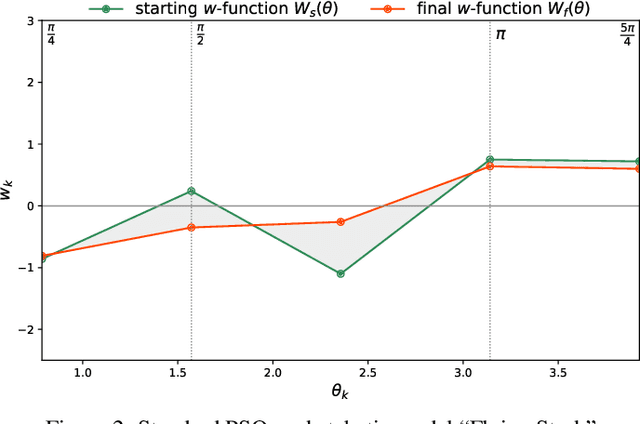

Abstract:Throughout the course of the development of Particle Swarm Optimization, particle inertia has been established as an important aspect of the method for researching possible method improvements. As a continuation of our previous research, we propose a novel generalized technique of inertia weight adaptation based on individual particle's fitness improvement, called anakatabatic inertia. This technique allows for adapting inertia weight value for each particle corresponding to the particle's increasing or decreasing fitness, i.e. conditioned by particle's ascending (anabatic) or descending (katabatic) movement. The proposed inertia weight control framework was metaoptimized and tested on the 30 test functions of the CEC 2014 test suite. The conducted procedure produced four anakatabatic models, two for each of the PSO methods used (Standard PSO and TVAC-PSO). The benchmark testing results show that using the proposed anakatabatic inertia models reliably yield moderate improvements in accuracy of Standard PSO (final fitness minimum reduced up to 0.09 orders of magnitude) and rather strong improvements for TVAC-PSO (final fitness minimum reduced up to 0.59 orders of magnitude), mostly without any adverse effects on the method's performance.
Search strategy in a complex and dynamic environment: the MH370 case
Apr 29, 2020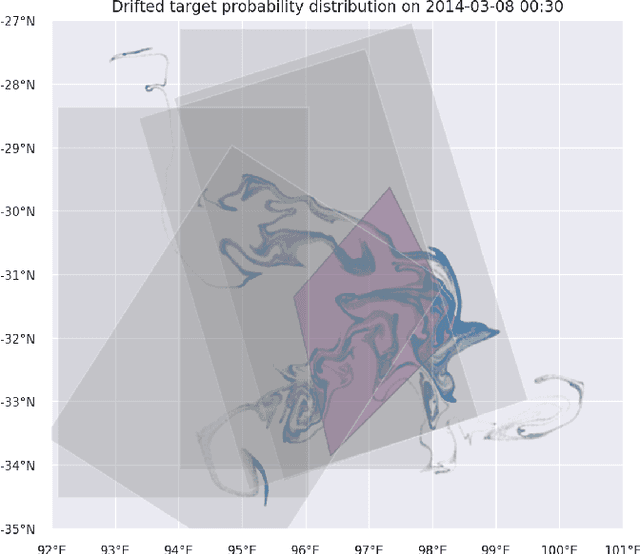
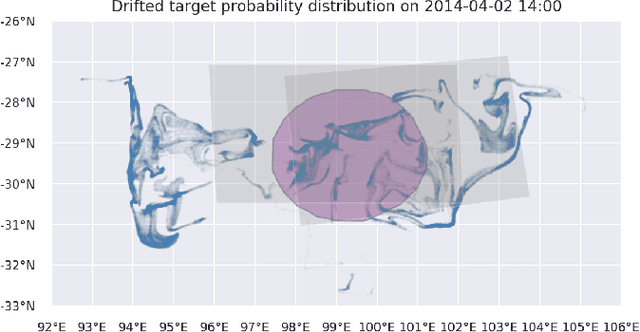
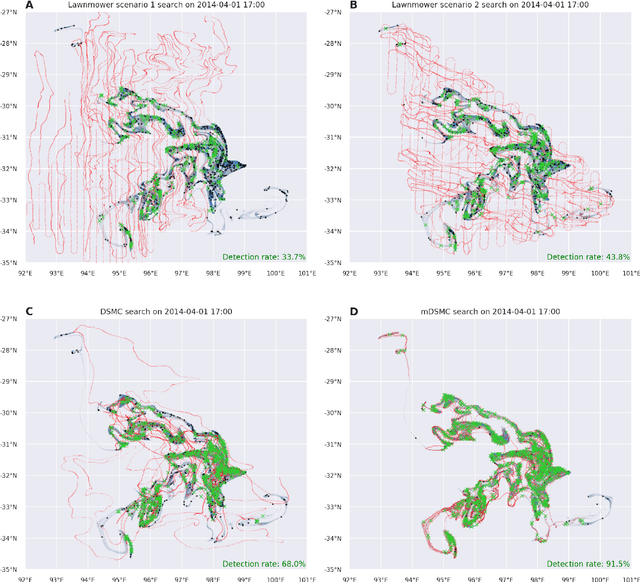
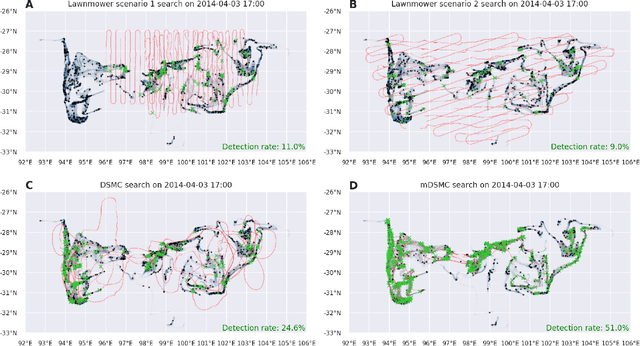
Abstract:Search and detection of objects on the ocean surface is a challenging task due to the complexity of the drift dynamics and lack of known optimal solutions for the path of the search agents. This challenge was highlighted by the unsuccessful search for Malaysian Flight 370 (MH370) which disappeared on March 8, 2014. In this paper, we propose an improvement of a search algorithm rooted in the ergodic theory of dynamical systems which can accommodate complex geometries and uncertainties of the drifting search areas on the ocean surface. We illustrate the effectiveness of this algorithm in a computational replication of the conducted search for MH370. In comparison to conventional search methods, the proposed algorithm leads to an order of magnitude improvement in success rate over the time period of the actual search operation. Simulations of the proposed search control also indicate that the initial success rate of finding debris increases in the event of delayed search commencement. This is due to the existence of convergence zones in the search area which leads to local aggregation of debris in those zones and hence reduction of the effective size of the area to be searched.
Motion control for autonomous heterogeneous multi-agent area search in uncertain conditions
Nov 20, 2019



Abstract:Using multiple mobile robots in search missions offers a lot of benefits, but one needs a suitable and competent motion control algorithm which is able to consider sensors characteristics, the uncertainty of target detection and complexity of needed maneuvers in order to make a multi-agent search autonomous. This paper provides a methodology for an autonomous two-dimensional search using multiple unmanned search agents. The proposed methodology relies on an accurate calculation of target occurrence probability distribution based on the initial estimated target distribution and continuous action of spatial variant search agent sensors. The core of the autonomous search process is a high-level motion control for multiple search agents which utilizes the probabilistic model of target occurrence via Heat Equation Driven Area Coverage (HEDAC) method. This centralized motion control algorithm is tailored for handling a group of search agents which are heterogeneous in both motion and sensing characteristics. The motion of agents is directed by the gradient of the potential field which provides near-ergodic exploration of the search space. The proposed method is tested on three realistic search mission simulations and compared with three alternative methods, where HEDAC outperforms all alternatives in all tests. Conventional search strategies need about double the time to achieve proportionate detection rate when compared to HEDAC controlled search. The scalability test showed that increasing the number of HEDAC controlled search agents, although somewhat deteriorating the search efficiency, provides needed speed-up of the search. This study shows the flexibility and competence of the proposed method and gives a strong foundation for possible real-world applications.
Introducing languid particle dynamics to a selection of PSO variants
Jun 06, 2019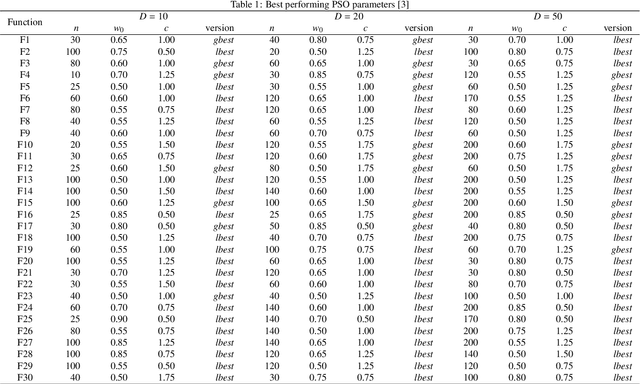
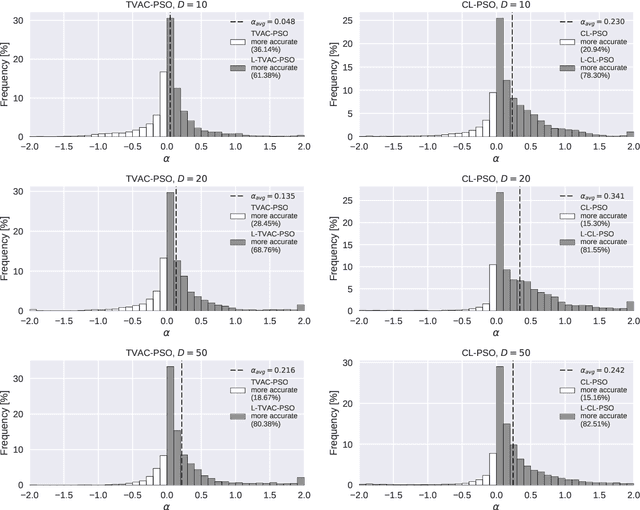


Abstract:Previous research showed that conditioning a PSO agent's movement based on its personal fitness improvement enhances the standard PSO method. In this article, languid particle dynamics (LPD) technique is used on five adequate and widely used PSO variants. Five unmodified PSO variants were tested against their LPD-implemented counterparts on three search space dimensionalities (10, 20, and 50 dimensions) and 30 test functions of the CEC 2014 benchmark test. In the preliminary phase of the testing four of the five tested PSO variants showed improvement in accuracy. The worst and best-achieving variants from preliminary test went through detailed investigation on 220 and 770 combinations of method parameters, where both variants showed overall gains in accuracy when enhanced with LPD. Finally, the results obtained with best achieving PSO parameters were subject to statistical analysis which showed that the two variants give statistically significant improvements in accuracy for 13-50% of the test functions.
 Add to Chrome
Add to Chrome Add to Firefox
Add to Firefox Add to Edge
Add to Edge